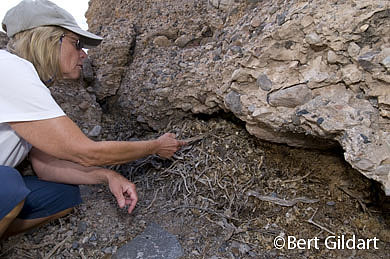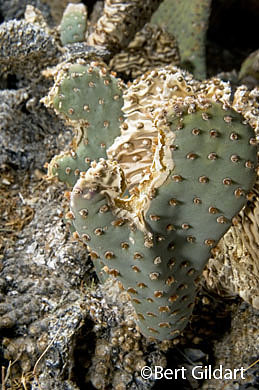Passionate About Packrat Poop
©Bert Gildart: Revolting as it may sound, much of the information about the character of Death Valley has been obtained from packrats and from the feces and urine they have deposited over the millennium.
“You’ll find packrat middens all over the park,” said Terry Baldino, Chief of Interpretation, in response to my question about their location. “But I’ll point you to one you can find quite easily.” (As an aside, Terry helped me with a story I wrote last year about global warming for the magazine produced by the Wilderness Society. As well, he helped with a book Janie and I wrote about Exploring Death Valley. You can, of course, order it from us or from Amazon.)
That’s what we spent much of yesterday doing, but certainly not the entire time since my last posting of several days ago. Since that time, we have taken a short break from Death Valley, making a two night stay in the nearby town of Pahrump. We wanted hookups and access to cable TV so that we might watch the historic inauguration. From Pahrump, we also said our goodbyes to Rich, Emma and Eleanor Luhr who had camped with us for several days at Furnace Creek. Our objectives complete, we returned to Death Valley and joined some other Airstream Trailer friends (Don and Nancy Dennis) whom we meet last summer in Glacier National Park. Don is retired from a dual career with the forest service and as a college professor. Nancy is retired from a career as an administrator with various companies, and because of their obvious interests in the outdoors, they were an ideal couple with whom to search for packrat middens.
WHAT’S IN A MIDDEN
By definition, a midden is a refuse pile that has accumulated over the centuries, and that is what packrats have provided in this valley now known as Death Valley. Thousands of years ago, a pair of packrats found a location that seemed ideal as a home and then began building a nest, using whatever vegetation was available.
Not being the most hygienic of animals, they would poop and pee in their nests. And so would their offspring, and the offspring that followed them and all successive generations. Such excretions would calcify around the vegetation used to construct their nest and so preserve it. In that way scientists who came along thousands of years later could look and say, “Ah ha! Here are the needles of a sequoia… a pinion pine.”
In this way they had some fairly conclusive evidence testifying to the nature of the climate many years ago. Hopefully, before leaving here, I’ll be able to visit with one of the biologists Terry said would be available later in the week.
PASSIONS REVEALED
After about an hour’s search up a dry wash, we found our nest, and I was not disappointed in the response of my companions. “Bert, it looks as though we’ve found the mother load!”
In their voices was genuine enthusiasm, making this the very best crew with whom to be hiking!
Our midden was located high on the flanks of the wash at the base of a huge boulder. Because such washes can at times funnel large quantities of flood waters, it would seem these rats had selected well. Other than that I can’t report much other but can say that the midden was large and that it seemed quite varied in construction.
Tangentially, I can also report that the rats seemed immune to the cholla from which a part of this particular nest seemed to have been constructed. We also observed that nearby they’d been nibbling on beavertail cactus, and that packrats have apparently learned how to avoid the thorns. One more thing I can confirm is that the nest was laden with feces and that it had a pungent odor.
With curiosity now peeked, my enthusiasm about these findings remains high, and now I’m anxious to learn what some of these droppings have revealed to park scientists. (Just imagine, some of this poop may be thousands of years old!)
Of course, you’ll want to log in again to discover whether my passion about packrat poop has waxed or whether it has waned. In fact, you may want to look us up down here where we are camped way below sea level. You’re welcome then to join us as we search for yet more middens, so very rich with story-telling feces.



